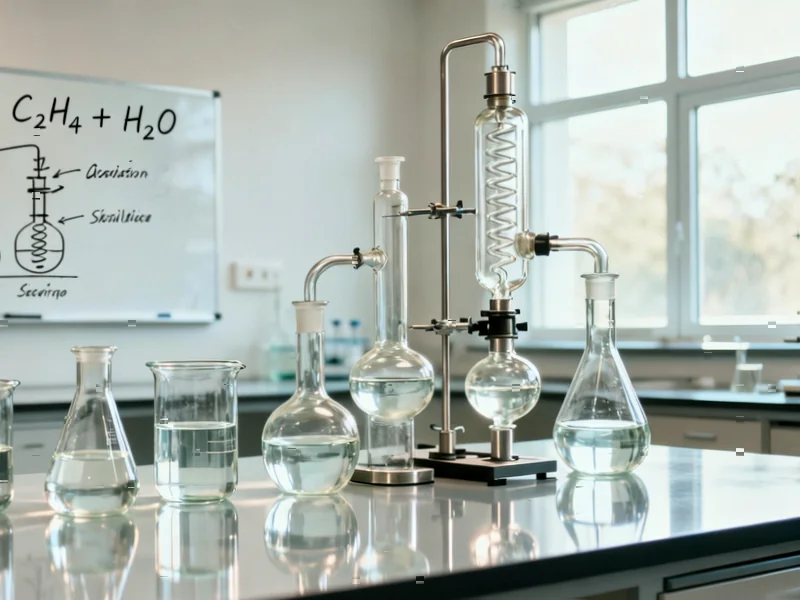According to science.org, chemists at Peking University have discovered a chemical additive that dramatically reduces carbon emissions from synthetic fuel production. The breakthrough, led by chemist Ding Ma, involves adding trace amounts of methyl bromide—just 20 parts per million—to the Fischer-Tropsch process, cutting carbon monoxide emissions from approximately 33% to less than 1%. The additive works by blocking water molecules from binding to iron catalysts, preventing unwanted side reactions that generate carbon pollution. The technology is already being commercialized by Synfuels China and could reduce emissions by hundreds of thousands of tons annually at large plants. This development represents a potential game-changer for cleaner synthetic fuel production.
Table of Contents
Solving a Century-Old Industrial Challenge
The Fischer-Tropsch process has been a double-edged sword since its invention in the 1920s. While it provides strategic energy security by converting abundant resources like coal and natural gas into liquid fuels, it has always suffered from fundamental inefficiency. The core issue lies in the chemistry itself—when carbon monoxide and hydrogen combine to form hydrocarbons, the leftover oxygen atoms create water that then reacts with more CO to generate substantial carbon monoxide pollution. What makes this breakthrough particularly elegant is that it doesn’t require redesigning the entire industrial process, but rather introduces a minimal additive that fundamentally changes the reaction pathway.
Broader Industrial Applications Beyond Fuels
While the immediate application focuses on synthetic fuels, the implications extend much further. The same catalytic principles govern numerous industrial processes that rely on syngas conversion, including production of chemicals, plastics, and other hydrocarbon-based materials. If this bromine-based inhibition approach proves scalable and cost-effective, it could transform multiple sectors that currently struggle with carbon efficiency. The key question becomes whether similar catalyst-blocking strategies can be developed for other metal catalysts beyond iron, potentially creating a new class of emission-reduction technologies for heavy industry.
The Scale-Up Challenge and Economic Realities
The transition from laboratory success to industrial implementation presents significant hurdles. Methyl bromide, while effective in trace amounts, brings its own environmental concerns—it’s classified as an ozone-depleting substance under the Montreal Protocol, though its use as a process additive rather than a refrigerant may fall under different regulatory considerations. The economics also remain uncertain: while reducing carbon waste improves efficiency, the additional costs of implementing and monitoring the additive system, plus potential catalyst lifetime effects, need thorough evaluation. For plants already operating on thin margins, the capital investment required for retrofitting existing Fischer-Tropsch facilities could be prohibitive without substantial regulatory pressure or carbon pricing incentives.
Environmental Trade-Offs in a Transition Era
This innovation arrives at a critical juncture in global energy transition. While reducing greenhouse gas emissions from synthetic fuels is undoubtedly positive, it also risks extending the lifespan of fossil fuel infrastructure at a time when many experts argue we should be accelerating the shift to renewables. The technology could make carbon-intensive fuel sources more economically viable precisely when we need to be phasing them out. However, for hard-to-decarbonize sectors like aviation and shipping that will likely rely on liquid fuels for decades to come, cleaner synthetic fuels represent a pragmatic intermediate solution rather than perpetuating direct fossil fuel use.
The Road Ahead for Cleaner Synthetic Fuels
The commercialization by Synfuels China suggests this technology has moved beyond theoretical promise, but widespread adoption will depend on several factors. Regulatory frameworks will need to evolve to properly account for and incentivize these efficiency improvements. The technology’s performance at commercial scale over extended periods remains unproven, and competing approaches like carbon capture and storage or alternative catalytic systems continue to develop. What’s clear is that this represents one of the most significant efficiency improvements in Fischer-Tropsch technology in decades, potentially breathing new life into a century-old process while making it more compatible with 21st-century climate goals.
Related Articles You May Find Interesting
- Interstellar Comet 3I/ATLAS: Why Science Trumps Alien Speculation
- China’s Secret Satellite Revealed in Final Moments Before Reentry
- AI’s Youth Revolution: How 22-Year-Olds Became Billionaires
- Canva’s AI-Powered Ambition: From Design Tool to Creative OS
- Apple’s November Strategy: Software Refinements and Holiday Surprises



